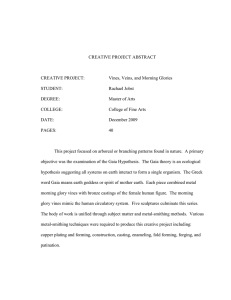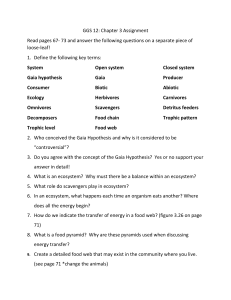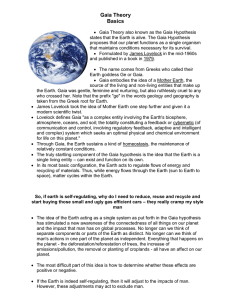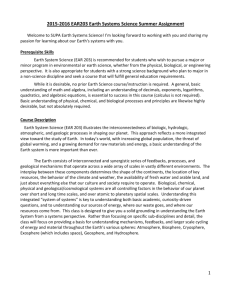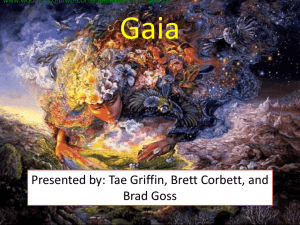Gaia
advertisement
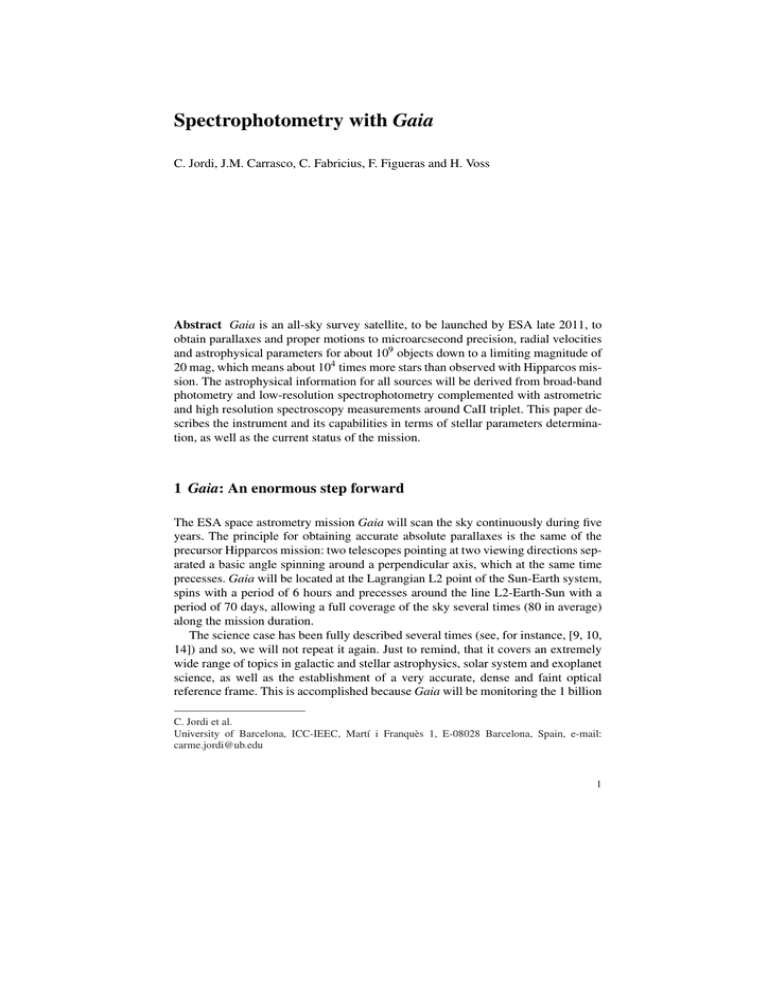
Spectrophotometry with Gaia C. Jordi, J.M. Carrasco, C. Fabricius, F. Figueras and H. Voss Abstract Gaia is an all-sky survey satellite, to be launched by ESA late 2011, to obtain parallaxes and proper motions to microarcsecond precision, radial velocities and astrophysical parameters for about 109 objects down to a limiting magnitude of 20 mag, which means about 104 times more stars than observed with Hipparcos mission. The astrophysical information for all sources will be derived from broad-band photometry and low-resolution spectrophotometry complemented with astrometric and high resolution spectroscopy measurements around CaII triplet. This paper describes the instrument and its capabilities in terms of stellar parameters determination, as well as the current status of the mission. 1 Gaia: An enormous step forward The ESA space astrometry mission Gaia will scan the sky continuously during five years. The principle for obtaining accurate absolute parallaxes is the same of the precursor Hipparcos mission: two telescopes pointing at two viewing directions separated a basic angle spinning around a perpendicular axis, which at the same time precesses. Gaia will be located at the Lagrangian L2 point of the Sun-Earth system, spins with a period of 6 hours and precesses around the line L2-Earth-Sun with a period of 70 days, allowing a full coverage of the sky several times (80 in average) along the mission duration. The science case has been fully described several times (see, for instance, [9, 10, 14]) and so, we will not repeat it again. Just to remind, that it covers an extremely wide range of topics in galactic and stellar astrophysics, solar system and exoplanet science, as well as the establishment of a very accurate, dense and faint optical reference frame. This is accomplished because Gaia will be monitoring the 1 billion C. Jordi et al. University of Barcelona, ICC-IEEC, Martı́ i Franquès 1, E-08028 Barcelona, Spain, e-mail: carme.jordi@ub.edu 1 2 C. Jordi, J.M. Carrasco, C. Fabricius, F. Figueras and H. Voss brightest sources on the sky. Expected accuracies are in the 7–25 µ as range down to 15 mag and sub-mas accuracies at the faint limit (20 mag). From the astrometric measurements of unfiltered (white) light, Gaia will yield G magnitudes in a very broad band covering the 350–1000 nm wavelength range, while the spectral energy distribution of each source will be sampled by a dedicated spectrophotometric instrument, with a dispersion between 4 and 32 nm/pixel. Gaia also features, for the brighter stars, a high-resolution (R=11500) integral field spectrograph, in the range 847–874 nm around CaII triplet, the so-called Radial Velocity Spectrometer (RVS) instrument. The total flux in RVS instrument will provide the GRVS magnitude. There are in total six mirrors per light path. The two primary mirrors are 1.45×0.5 m2 in size. The two fields of view are combined in a unique focal plane of about 1×0.5 m2 in size with 106 CCDs. Figure 1 shows the focal plane with its different sections. Gaia’s observations are made with high-quality, large-format CCDs operated in integration (TDI) mode, with charge images being transported in synchrony with optical images moving across the field due to the rotation of the satellite. The sources are (a) detected in the sky mappers, which only see one field of view each, (b) further confirmed as a source or rejected in the first strip of CCDs in the astrometric section and, if confirmed, (c) an image window around the position of the source on every transiting CCD is downloaded to the ground. If the source is bright enough (brighter than about 16.5 mag) it will be observed with the radial-velocity spectrometer as well. Fig. 1 Combined focal plane. The sources are detected in the sky mappers and observed on 9 astrometric CCDs, blue and red photometers and if bright enough in the radial-velocity spectrometer. Figure courtesy of J. de Bruijne. The mission operation is fully funded by ESA. On February of 2006, EADSAstrium was selected as prime contractor by the Science Programme Committee of ESA. Currently, the mission is in phase C/D after the Preliminary Design Review was passed in July 2007. The major current concerns are on the basic angle stability, the mitigation of the radiation damage and the performances of the radial velocity Spectrophotometry with Gaia 3 spectrometer. Efforts are being made to improve these topics. With a launch foreseen at December 2011 (see Fig.2), transfer to L2, commissioning phase, routine science operations lasting 5 years, with a possible 1 year extension, and data processing, the final catalogue is expected around 2021. The ingestion of the large amount of data that Gaia will obtain is analyzed in [7, 12] in this volume. The list of persons currently involved in the Gaia Data Processing and Analysis Consortium (DPAC ) includes some 370 people, not counting the industrial contractors. The community of scientists interested in Gaia is much larger, due to the wide science case. Fig. 2 Gaia schedule. The mission is in phase C/D and DPAC is preparing the data processing. 2 Aim of spectrophotometry Gaia measurements will provide the basic diagnostics for classifying all sources as stars, quasars, solar-system objects, or otherwise, and for parameterizing them according to their nature. Stellar classification and parameterization across the entire Hertzsprung-Russell diagram is required as well as the identification of peculiar objects. This demands observations in a wide wavelength range, extending from the very blue to the infrared. The photometric data must determine: (i) effective temperatures and reddening at least for O-B-A stars (needed both as tracers of Galactic spiral arms and as reddening probes), (ii) at least effective temperatures and abundances for F-G-K-M giants and dwarfs, (iii) luminosities (gravities) for stars having large relative parallax errors, (iv) indications of unresolved multiplicity and peculiarity, and (v) a map of the interstellar extinction in the Galaxy. All of this has to be done with an accuracy sufficient for stellar age determination in order to allow a quantitative description of the chemical and dynamical evolution of the Galaxy over 4 C. Jordi, J.M. Carrasco, C. Fabricius, F. Figueras and H. Voss all galactocentric distances. Separate determination of Fe- and α -elements abundances is essential for mapping Galactic chemical evolution and understanding the formation of the Galaxy. Photometry is also crucial to identify and characterize the set of ∼ 500 000 quasars that the mission will detect. Apart from being astrophysically interesting in their own right, quasars are key-objects for defining the fixed, non-rotating Gaia Celestial Reference Frame, the optical equivalent of the International Celestial Reference Frame ([9]). On the other hand, Gaia will identify about 900 quasars (QSO) with multiple images produced by macrolensing. Since this number is sensitive to cosmological parameters, the Gaia observations will be able to constrain the latter. Due to diffraction and optical aberrations of the instrument, the position of the centre of the stellar images is wavelength dependent. To achieve the microarcsec accuracy level, astrometry has to be corrected for this chromatic aberration through the knowledge of the spectral energy distribution of the observed objects. Photometry is indispensable for this. If uncorrected, chromatic errors could reach several milliarcsec. 3 Spectrophotometry instrument The spectrophotometric instrument consists on two low-resolution slitless spectrographs maded of fused silica and named BP (‘blue photometer’) and RP (‘red photometer’). They cover the wavelength intervals 330–680 nm and 650–1050 nm, respectively, and their resolution was designed in such a way to provide the same science outputs that the set of photometric passbands proposed by the scientific community [5]. Both spectra have similar lengths in order to provide similar angular resolution, which is able to deal with stellar densities of up to 750 000 sources deg−2 . The total flux of these BP and RP spectra will yield GBP and GRP magnitudes as two broad passbands. Therefore, four passbands and their corresponding magnitudes, can be associated with the Gaia instruments: G, GBP , GRP and GRVS . Figures 3 (left) and 4 show the four passbands and colour-colour diagrams, respectively. The late involves Johnson-Cousins B, V and Ic passbands and provide relationships computed using 141 spectra in Pickles’s library [11]. The white light observations, G band photometry, will yield the best signal-tonoise ratio and hence is the most suitable for variability detection. One source will be observed by the two fields of view with a separation of 1.6 hours and repeated again after a revolution of the satellite after 6 hours. The spectral resolution is a function of wavelength as a result of the natural dispersion curve of fused silica; the dispersion is higher at short wavelengths, and ranges from 4 to 32 nm pixel−1 for BP and from 7 to 15 nm pixel−1 for RP. The variation across-scan does not exceed ±6% for BP and ±4% for RP. Figure 5, based on simulated spectra provided by [2], shows the observations for two stars (Teff = 8500 and 3500 K), which SEDs have been taken from BaSeL-2.2 spectral library [6]. Spectrophotometry with Gaia 5 0 1 10 G BP RP GRVS 0.9 B1V F2V G2V K3III M0III -1 10 0.7 0.6 σG (mag) normalized response to energy 0.8 0.5 s) pe r s ob on ati erv (9 D CC -2 10 0.4 0.3 -3 bse 0o 10 n (7 rv.) issio f-m d-o 0.2 en 0.1 0 300 -4 400 500 600 700 800 wavelength (nm) 900 1000 10 1100 14 16 18 V 20 22 Fig. 3 Left: Response curves yielding G, GBP , GRP and GRVS . Right: Expected precisions for G fluxes as a function of magnitude for a single transit and at the end-of-mission. A threshold of 1 mmag has been marked. 10 0.0 8 -1.0 6 BP-RP -2.0 G-V Av=0 Av=1 Av=3 Av=5 -3.0 4 -4.0 2 -5.0 Av=0 Av=1 Av=3 Av=5 -6.0 -7.0 0.0 1.0 0 2.0 3.0 V-IC 4.0 5.0 6.0 7.0 -2 -1 0 1 2 3 4 5 6 7 8 9 10 V-I Fig. 4 Colour-colour diagrams involving Gaia passbands and Johnson-Cousins B, V and Ic passbands. Different colours are used for different absorption values. End-of-mission error bars for G = 15 and 18 are shown. Different spectra displayed correspond to different surface gravities and different metallicities. The differences are relevant compared to the error bars. 4 Calibration principle Gaia is essentially a self-calibrated mission with a strong inter-relationship among astrometric, photometric and spectroscopic data. The calibration parameters and the fluxes and spectra of the sources are solved for in an iterative procedure that updates the solutions as new data come in. The procedure is based on a large set of internally defined “well-behaved” sources. The variations in response and wavelength scale across the focal plane, and with time, will be monitored taking advantage of the scanning mode in which Gaia will 6 C. Jordi, J.M. Carrasco, C. Fabricius, F. Figueras and H. Voss λ (nm) 330 2.5e+05 500 600 1.5 2.0 2.5 3.0 3.5 4.0 4.5 5.0 2.0e+05 Photon counts 400 1.5e+05 1.0e+05 5.0e+04 0.0e+00 30 25 20 15 10 5 0 Pixel coordinate Fig. 5 1D spectra based on simulations from [2] for a Teff = 8500 K star with several logg observed in BP (left panel) and for a Teff = 3500 K star with several [M/H] observed in RP (right panel). The end-of-mission error bars in the violet line correspond to G = 18 and in the black line to G = 15. be operated. For average stellar densities on the sky about 60 stars per CCD per second will cross the focal plane. This translates to about 660 stars per pixel column per 6 hours (Gaia spin period). The same stars are observed repeatedly in different parts of the focal plane on time scales varying from hours to weeks to months, up to the mission life time of 5 years. There will thus be plenty of measurements to perform detailed CCD calibrations on scales from pixel columns to CCDs. The photometric system will be defined by the average response for all the CCDs over the duration of the mission. The conversion to absolute fluxes will be based on a set of 100-150 SpectroPhotometric Standard Stars (SPSS). For this, we are conducting an specific ground based observational project at 2.2m@CAHA, TNG@La Palma, NTT@La Silla, REM@La Silla, 1.5m@SanPedro and Cassini@Loiano. We wish to achieve 1-2% precision based on Vega for a set of 100-150 SPSS. Medium resolution spectra and photometry are being obtained, both for absolute calibrating the spectra and for monitoring variability at small and large time baseline. To know more details about Gaia photometric calibration see [3] in this volume. 5 Results The Besançon Galaxy Model [13] has been used to simulate the content of the Galaxy and the stellar population that Gaia will observe (see Fig. 6 and [4, 8], in this volume). In total, the simulations predict about 300 million stars with parallax errors better than 10% and 30 million stars with precisions better than 1%. All parts of the HR diagram and all type of variable stars will be well covered, so absolute luminosities for all of them will be derived. The simulations have been used to establish internal calibration models and to evaluate precisions and systematics. The first results show that the calibration errors Spectrophotometry with Gaia 7 Fig. 6 Sky density from Gaia Universe Model Snapshot (GUMS) up to G = 20. Fig. 7 Precision of Av , [M/H], logg anf Teff determination for an F IV star at different distances as a function of G. The largest errors in σ[M/H] corresponds to very metal poor stars, with [M/H]=-4.0. could be below 1 mmag. Figure 3 (right) shows the expected precisions for G fluxes as a function of magnitude for a single focal plane crossing (9 CCDs) and at the end-of-mission (assumed 70 observations for safety). Precision of the astrophysical parameters have been preliminary estimated taking into account poisson, background and readout noises. Parallax value has been introduced as an additional information into the procedure. As an example, Fig. 7 8 C. Jordi, J.M. Carrasco, C. Fabricius, F. Figueras and H. Voss shows the estimated precision of Av , [M/H], logg and Teff determination for F-type dwarfs as a function of G magnitude. These stars are key for the halo and old disk age determination. According to [1], at G = 15, the uncertanties derived are 1% in Teff for a wide range types (OB to K stars); AV , to 0.05–0.1 mag for hot stars; lower than 0.2 dex in [Fe/H] for spectral types later than F down to ∼ 2.0 dex metallicity; logg to between 0.1 and 0.4 dex for all luminosity classes, but to better than 0.1 dex for OBA stars. The performance varies a lot with the physical parameters themselves, as well as with G magnitude (i.e. signal-to-noise ratio). Neural Network algorithms have been applied to parametrize the stars, see for instance [15]. The systematic trends have been evaluated as a function of Av , [M/H], logg and Teff . The largest ones are for the determination of [M/H] for hot stars and very metal poor, as it can be anticipated. In fact, in Fig. 7, the largest errors corresponds to very metal poor stars, with [M/H]=-4.0. The correlations between [M/H] and logg determinations will be improved by introducing the parallax information into the classification algorithms. Acknowledgements This research has been granted by MCyT under contracts ESP2006-26356E, ESP2006-13855-C02-01. References 1. Bailer-Jones, C.A.L., What will Gaia tell us about the Galactic disk?, The Galaxy disk in a cosmological context Proceedings IAU Symposium No. 254, 2008. 2. Brown, A., 2006a, Simulating Prism Spectra for the Revised Gaia Design Proposed by Astrium, Internal Gaia report: GAIA-CA-TN-LEI-AB-005-7. 3. Carrasco, J. M., Voss, H., Jordi, C., Fabricius, C., Figueras, F., Calibration model for Gaia photometry and spectroscopy, this volume. 4. Isasi, Y., Luri, X., Robin, A., Gaia Universe Model Snapshot, this volume. 5. Jordi,C, Høg, E., Brown, A.G.A., Lindegren, L., Bailer-Jones, C.A.L., Carrasco, J.M., Knude, J., Straiz̆ys, V., de Bruijne, J.H.J, Claeskens, J.-F., and 25 coauthors, 2006, MNRAS 367, 290 6. Lejeune Th., Cuisinier F., Buser R., 1997, A&AS 125, 229 7. Luri, X. et al. Preparation of Gaia data processing: First results, this volume. 8. Masana, E., Isasi, Y., Luri, X., Peralta, J., Gaia simulator: Design and results, this volume. 9. Mignard F., 2005, in Proceedings of the Symposium ‘The Three Dimensional Universe with Gaia’, ESA SP-576, p. 5 10. Perryman M. A. C., de Boer K. S., Gilmore G., Høg E., Lattanzi M. G., Lindegren L., Luri X., Mignard F., Pace O., de Zeeuw P. T., 2001, A&A, 369, 339 11. Pickles A. J., 1998, PASP 110, 863 12. Portell, J., Castañeda, J., Isasi, Y., Fabricius, C., Luri, X., Torra, J., Vicente, D., Massive parallelization of a space mission simulator and data processing system, this volume. 13. Robin A. C., Reyl C., Derrière S., Picaud S., 2003, A&A 409, 523 14. Torra, J., 2007, Highlights of spanish astrophysics IV, Proceedings of the seventh Scientific Meeting of the Spanish Astronomical Society (SEA) held in Barcelona, Spain, September 12-15, 2006, Springer, Eds. Figueras, Guitart, Hernanz & Jordi. 15. Willemsen P. G., Kaempf T. A., de Boer K. S., Bailer-Jones C. A. L., 2005, Using distance information in the process of automated parametrization – preliminary results, Gaia technical report ICAP-PW-005
